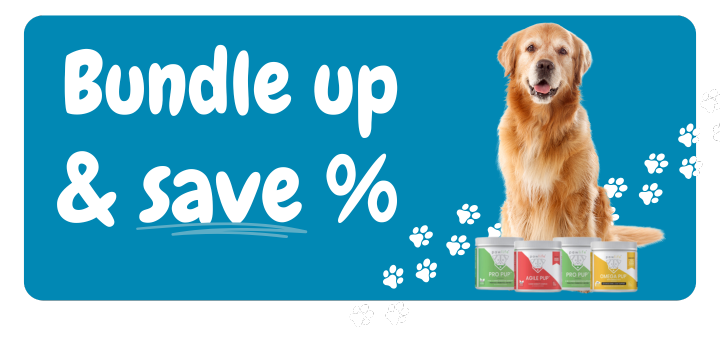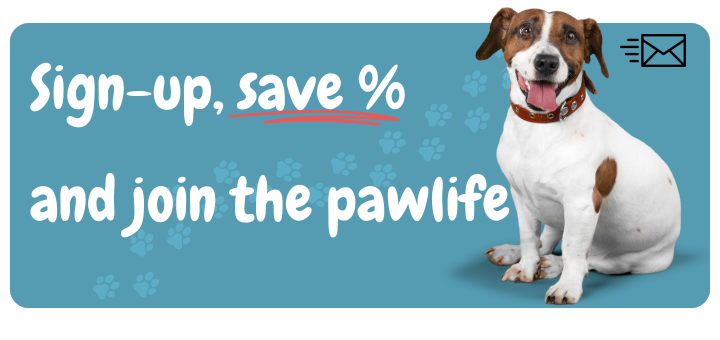Why Storms Can Feel So Scary To Your Dog
Thunder, heavy rain, and lightning bring a mix of loud noises, changes in air pressure, bright flashes, and even static electricity. Dogs hear and feel all of this far more intensely than we do. A rumble that sounds distant to you can feel like it is happening right next to your pup. For dogs that already struggle with worry or separation stress, storms can act as a major trigger and quickly spiral into panic.
If your dog already shows signs of stress in daily life, such as pacing, whining, or shadowing you from room to room, you may find our article Dog Anxiety 101: How To Recognize Stress In Your Pup helpful before storm season begins. Understanding your dog’s baseline makes it easier to spot when weather worries are starting to build.
Early Signs Your Dog Is Afraid Of Thunderstorms
Physical Cues Of Stress
Storm anxiety often begins with subtle physical signals. You might notice trembling, lip licking, panting when the house is cool, dilated pupils, pinned-back ears, or a tucked tail. Some dogs shed more heavily when they are nervous or pace from window to window as thunder approaches. These body language changes are your dog’s way of saying, “Something feels wrong.”
Behavior Changes During Rain And Thunder
Other dogs respond with behavior shifts: hiding in the bathroom, scratching at doors, barking at every rumble, or clinging to you and refusing to leave your side. In more severe cases, storm fear can look like destructive chewing or frantic digging at carpets and window frames. If your dog chews when stressed, pair this guide with How To Stop Your Dog From Chewing Things Up so you can protect both your pup and your home.
Preparing Before Storm Season Starts
The best thunderstorm plan begins long before the first crack of lightning. Check your local forecast regularly so you are not caught off guard, and think of storm preparation as part of your dog’s overall wellness routine. A dog that is well-rested, eating an appropriate diet, and supported with daily supplements often copes better with short-term stressors.
For a bigger-picture wellness plan, explore Prioritizing Your Dog’s Overall Wellness and consider adding a broad support multivitamin like Multi Pup 5-in-1 Dog Multivitamin to keep joints, immunity, and digestion in good shape year-round.
Designing A Safe Storm Sanctuary
Choosing The Right Safe Space
Pick a quiet, interior area away from big windows—many dogs feel safest in a bathroom, walk-in closet, or finished basement. Add a supportive bed, soft blankets, and a favorite toy or two. You can even turn a covered crate into a cozy “storm bunker” for dogs that already love their crate. The goal is to give them a predictable, comforting space where sound and flashes are muted.
Using Sound And Scent To Soothe
White noise, soft music, or a TV turned to a calm channel can help drown out thunder. Some dogs relax with slow, classical music; others prefer steady fan noise. You can combine this with a familiar scent, like your unwashed t-shirt on the bed, to build a stronger feeling of safety. If your dog usually enjoys enrichment games, tuck a food-puzzle or long-lasting chew into the safe space so they have something positive to focus on as the storm passes.
Your Own Calm Matters More Than You Think
Dogs read our body language and tone of voice constantly. If you gasp at every lightning flash or rush around closing windows, your dog may assume there is a real danger. Move at a normal pace, speak in a warm, relaxed voice, and sit near them without hovering. Simple behaviors—casually tossing a few treats, scrolling your phone, or reading a book in the same room—signal that the situation is manageable.
If you know you tend to worry yourself, review the mindset tips in Easing Dog Anxiety: Practical Tips And Calming Supplements so you can be a steady anchor for your pup when the weather turns wild.
Training Games That Build Confidence Around Storm Sounds
Gradual Sound Desensitization
Once your dog is relaxed on a normal day, you can introduce recorded storm sounds at a very low volume during fun activities. Play rain and thunder recordings while you serve dinner, practice simple tricks, or enjoy a gentle play session. Keep the volume low enough that your dog notices the sound but stays comfortable. Over many short sessions, slowly increase the volume, always pairing it with good things like treats or praise.
“Look At That” And Reward Calm
During real storms, mark and reward every tiny sign of bravery. When your dog hears thunder and glances toward the window without panicking, calmly say “yes” and offer a treat or their favorite chew. Over time, your dog may begin to associate thunder with the possibility of snacks or snuggles instead of fear. For a wider look at building resilience through games, see Fit And Furry: Exercises You Can Do With Your Pet .
How Calming Supplements Fit Into Your Plan
Comforting routines and safe spaces create the foundation, and calming supplements can add an extra layer of support for storm-sensitive dogs. The Calming collection at Pawlife is designed for exactly these moments, with ingredients chosen to promote relaxation while keeping your dog alert and responsive.
Using Calm Pup Before And During Storms
Soft chews like Calm Pup Duck Flavor and Calm Pup Bacon Flavor combine natural ingredients such as chamomile, passionflower, and L-theanine to support a steady, relaxed mood. Offering a serving 30–60 minutes before a forecasted storm can help take the edge off rising anxiety. For dogs that worry through holidays and houseguests as well, pair this article with Keep Your Dog Calm During The Holidays With Calm Pup Chews so you can build a consistent calming routine across stressful seasons.
Stacking Support For The Mind And Body
Many dogs with storm anxiety also benefit from gut and immune support, since stress can upset digestion. If your dog experiences loose stools or gurgly stomach after storms, read Tips To Support Better Digestion For Your Pup and consider a digestive supplement such as Pro Pup from the Digestion collection. Calmer guts often go hand-in-hand with calmer minds.
Extra Help For Puppies, Seniors, And Working Dogs
Storm Support For Puppies
Young dogs are still forming opinions about the world, which makes early experiences during storms especially important. Pair mild spring showers with fun training games, gentle tug sessions, and tiny servings of Calm Pup when needed. If you are already planning their long-term wellness routine, combine this with guidance from How To Know When Your Puppy Is Ready For Adult Dog Food so nutrition and emotional support grow together.
Supporting Senior Dogs Through Storm Season
Older dogs may struggle more during storms because arthritis, hearing changes, or vision loss leave them feeling vulnerable. Gentle mobility support from Agile Pup in the Hip & Joint collection can make it easier for them to move to their safe space or settle comfortably on a supportive bed. For more aging-specific tips, you can explore How To Care For Your Senior Dog and Recognizing Early Signs Of Arthritis In Dogs And Providing Support .
When Professional Help Is The Next Right Step
Some dogs experience such intense storm phobia that home strategies and supplements are not enough on their own. If your dog injures themselves, cannot settle at all, or refuses to eat and drink during storms, schedule an appointment with your veterinarian. They might recommend anti-anxiety medications, prescription diets, or a referral to a veterinary behaviorist for a detailed behavior modification plan.
Bring a written summary of your dog’s behavior, along with any notes about how they respond to tools from this article and from Is Your Dog Stressed? Here’s How To Tell . The more information your vet has, the easier it becomes to design a plan tailored to your dog’s needs.
Your Storm Season Calm-Down Checklist
Helping a storm-sensitive dog feel safe is an ongoing partnership, not a one-time fix. Small, consistent steps add up:
- Create a quiet storm sanctuary with soft bedding, toys, and soothing sound.
- Stay relaxed yourself so your dog reads your calm body language.
- Use training games and gradual sound exposure to change how your dog feels about thunder.
- Offer targeted calming support from the Calming collection, including Calm Pup Duck or Calm Pup Bacon.
- Support digestion and overall wellness with options like Pro Pup and Multi Pup 5-in-1.
- Work with your veterinarian if anxiety remains intense or worsens over time.
With preparation, patience, and the right combination of calming tools and wellness support, thunderstorms can shift from a source of panic to just another rainy day your dog spends safely by your side.













